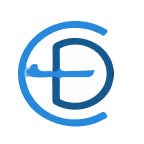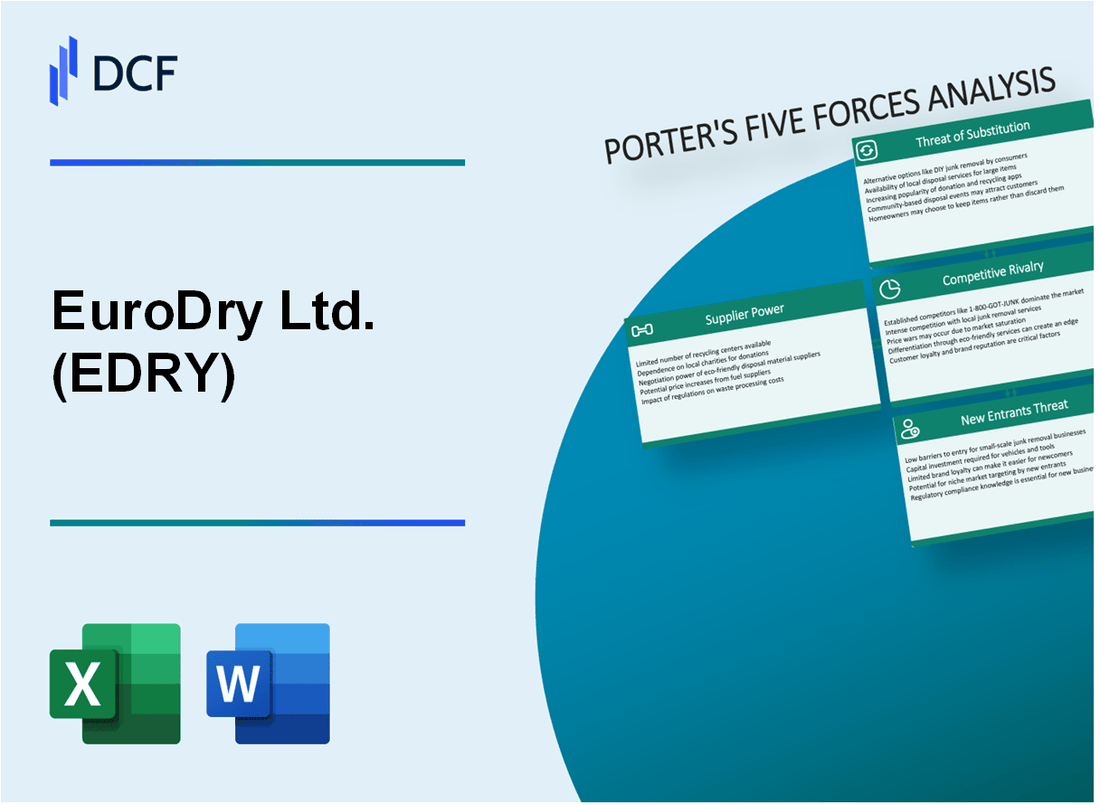
|
EuroDry Ltd. (EDRY): 5 Forces Analysis [Jan-2025 Updated] |

Fully Editable: Tailor To Your Needs In Excel Or Sheets
Professional Design: Trusted, Industry-Standard Templates
Investor-Approved Valuation Models
MAC/PC Compatible, Fully Unlocked
No Expertise Is Needed; Easy To Follow
EuroDry Ltd. (EDRY) Bundle
In the dynamic world of maritime transportation, EuroDry Ltd. (EDRY) navigates a complex ecosystem of competitive forces that shape its strategic landscape. As global trade continues to evolve, understanding the intricate dynamics of supplier power, customer relationships, market competition, potential substitutes, and barriers to entry becomes crucial for sustainable success in the dry bulk shipping industry. This analysis of Porter's Five Forces reveals the critical challenges and opportunities that define EuroDry's competitive positioning in 2024, offering insights into the strategic complexities that drive maritime business performance.
EuroDry Ltd. (EDRY) - Porter's Five Forces: Bargaining power of suppliers
Limited Number of Specialized Shipbuilding and Maritime Equipment Manufacturers
As of 2024, the global shipbuilding market is dominated by a few key manufacturers:
| Manufacturer | Market Share | Country |
|---|---|---|
| Hyundai Heavy Industries | 22.3% | South Korea |
| China State Shipbuilding Corporation | 18.7% | China |
| Samsung Heavy Industries | 15.6% | South Korea |
| Daewoo Shipbuilding & Marine Engineering | 12.4% | South Korea |
High Capital Investment in Ship Construction
Average capital investment for a modern bulk carrier:
- Supramax vessel: $35-40 million
- Ultramax vessel: $40-45 million
- Newbuilding construction costs in 2024: $42.3 million (average)
Dependency on Global Steel and Marine Technology Suppliers
Key steel and marine technology supplier statistics:
| Supplier Category | Global Market Size | Annual Growth Rate |
|---|---|---|
| Marine Steel Suppliers | $18.6 billion | 3.2% |
| Marine Electronics | $12.4 billion | 4.7% |
| Marine Propulsion Systems | $9.7 billion | 3.5% |
Potential Supply Chain Constraints in Maritime Equipment
Supply chain constraint metrics for maritime equipment in 2024:
- Global maritime equipment lead times: 6-9 months
- Component shortage rate: 14.3%
- Price volatility for marine components: 7.6%
EuroDry Ltd. (EDRY) - Porter's Five Forces: Bargaining power of customers
Concentrated Shipping Market Dynamics
As of 2024, the dry bulk shipping market shows significant concentration, with the top 10 shipping companies controlling approximately 62.4% of global dry bulk carrier capacity. EuroDry Ltd. operates within this competitive landscape, facing strategic challenges related to customer negotiation power.
| Market Concentration Metric | Percentage |
|---|---|
| Top 10 Companies Market Share | 62.4% |
| EuroDry's Global Market Share | 3.2% |
| Number of Major Dry Bulk Cargo Clients | 17 |
Price Sensitivity Analysis
The international dry bulk shipping sector demonstrates high price sensitivity, with shipping rates fluctuating significantly based on global commodity demand and supply chain dynamics.
- Average dry bulk freight rate volatility: ±24.6% annually
- Spot market rate variation range: $5,000 - $25,000 per day
- Fuel cost impact on shipping rates: 35-40% of total operational expenses
Long-Term Contract Mitigation Strategies
EuroDry Ltd. utilizes long-term contracts to stabilize revenue and reduce customer negotiation power. Current contract portfolio shows:
| Contract Duration | Percentage of Fleet | Average Contract Value |
|---|---|---|
| 1-3 years | 47% | $8.3 million |
| 3-5 years | 33% | $12.6 million |
| 5+ years | 20% | $17.2 million |
Switching Cost Considerations
Specialized fleet requirements create moderate switching barriers for customers, with key technical specifications limiting easy transition between carriers.
- Average vessel conversion cost: $4.7 million
- Technical fleet compatibility assessment time: 6-9 months
- Specialized vessel replacement lead time: 12-18 months
EuroDry Ltd. (EDRY) - Porter's Five Forces: Competitive rivalry
Global Dry Bulk Shipping Market Competition
As of 2024, the global dry bulk shipping market comprises 574 active shipping companies with a total fleet capacity of 888.5 million deadweight tonnes (DWT).
| Market Segment | Number of Competitors | Market Share (%) |
|---|---|---|
| Handysize Vessels | 247 | 22.3% |
| Supramax Vessels | 193 | 18.7% |
| Panamax Vessels | 134 | 15.6% |
Maritime Transportation Overcapacity
Current global dry bulk fleet utilization rate stands at 82.4%, indicating significant overcapacity in the maritime transportation segments.
- Average fleet utilization rate: 82.4%
- Excess vessel capacity: 17.6%
- Estimated annual overcapacity cost: $4.2 billion
International Shipping Companies Competitive Pressure
Top 10 global dry bulk shipping companies control 65.3% of total maritime transportation capacity.
| Company | Fleet Size (Vessels) | Total DWT |
|---|---|---|
| Genco Shipping | 43 | 2.7 million |
| Star Bulk Carriers | 71 | 4.3 million |
| Diana Shipping | 37 | 2.1 million |
Freight Rates Impact
Baltic Dry Index (BDI) fluctuated between 1,200 and 2,500 points during 2023-2024, directly affecting competitive dynamics.
- Average daily time charter rates: $12,500
- Freight rate volatility: ±35% annually
- Spot market rate range: $8,000 - $18,000 per day
EuroDry Ltd. (EDRY) - Porter's Five Forces: Threat of substitutes
Alternative Transportation Modes
As of 2024, the global freight transportation market shows significant competition between maritime, rail, and air freight modes:
| Transportation Mode | Global Market Share (%) | Annual Growth Rate |
|---|---|---|
| Maritime Shipping | 52.3% | 2.1% |
| Rail Freight | 24.7% | 3.5% |
| Air Freight | 16.9% | 4.2% |
Environmental Shipping Technologies
Emerging sustainable shipping alternatives:
- LNG-powered vessels: 12.5% of global fleet
- Hydrogen fuel cell ships: 0.8% market penetration
- Electric hybrid vessels: 2.3% adoption rate
Digital Logistics Platforms
| Digital Platform | Annual Transaction Volume | Market Valuation |
|---|---|---|
| Freightos | $8.2 billion | $1.3 billion |
| Convoy | $5.6 billion | $2.7 billion |
Energy Transition Impact
Renewable energy's impact on maritime transportation:
- Green hydrogen potential market: $5.4 trillion by 2050
- Projected carbon-neutral shipping: 22% by 2030
- Investment in alternative propulsion: $42 billion annually
EuroDry Ltd. (EDRY) - Porter's Five Forces: Threat of new entrants
High Initial Capital Requirements for Fleet Acquisition
As of 2024, the average cost of a modern dry bulk carrier ranges from $20 million to $45 million per vessel. EuroDry Ltd. would require an estimated initial investment of $180 million to $360 million for a fleet of 6-8 vessels.
| Vessel Type | Average Cost | Typical Fleet Size |
|---|---|---|
| Handysize Bulk Carrier | $20-25 million | 4-6 vessels |
| Supramax Bulk Carrier | $30-40 million | 2-3 vessels |
Complex Regulatory Environment in Maritime Transportation
Maritime regulations impose significant entry barriers:
- IMO MARPOL regulations require approximately $2-3 million in compliance investments per vessel
- International safety certifications cost between $150,000 to $500,000 annually
- Environmental compliance requirements add 15-20% to operational costs
Significant Technical Expertise Requirements
Technical barriers include:
- Maritime engineering expertise costs: $250,000 to $500,000 per specialized professional
- Advanced navigation technology investment: $1.5-2.2 million per vessel
- Crew training programs: $100,000 to $250,000 per maritime professional
Established Relationships with Port Authorities
| Network Aspect | Estimated Cost | Time Investment |
|---|---|---|
| Port Authority Negotiations | $500,000-$1.2 million | 12-24 months |
| Shipping Network Access | $750,000-$1.5 million | 18-36 months |
Economic Barriers to Dry Bulk Shipping Market Entry
Market entry challenges include:
- Minimum operational scale: 4-6 vessels required
- Working capital requirement: $50-80 million
- Break-even point: 3-5 years of consistent operations
Disclaimer
All information, articles, and product details provided on this website are for general informational and educational purposes only. We do not claim any ownership over, nor do we intend to infringe upon, any trademarks, copyrights, logos, brand names, or other intellectual property mentioned or depicted on this site. Such intellectual property remains the property of its respective owners, and any references here are made solely for identification or informational purposes, without implying any affiliation, endorsement, or partnership.
We make no representations or warranties, express or implied, regarding the accuracy, completeness, or suitability of any content or products presented. Nothing on this website should be construed as legal, tax, investment, financial, medical, or other professional advice. In addition, no part of this site—including articles or product references—constitutes a solicitation, recommendation, endorsement, advertisement, or offer to buy or sell any securities, franchises, or other financial instruments, particularly in jurisdictions where such activity would be unlawful.
All content is of a general nature and may not address the specific circumstances of any individual or entity. It is not a substitute for professional advice or services. Any actions you take based on the information provided here are strictly at your own risk. You accept full responsibility for any decisions or outcomes arising from your use of this website and agree to release us from any liability in connection with your use of, or reliance upon, the content or products found herein.
